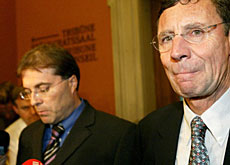The rise and fall of the Christian Democrats

One of the country’s enduring political forces, the Christian Democratic Party, is facing the most serious threat yet to its political future.
The party is under heavy pressure to relinquish one of its two seats in government to make way for the rightwing populist, Christoph Blocher, in Wednesday’s cabinet elections.
The party has been a fixture in the Swiss cabinet for over a century, but its power base has been shrinking in recent years.
It recorded its worst ever result in last October’s election to become the smallest of the four main parliamentary parties.
Party roots
The roots of the Christian Democrats go back to the conservative, Catholic milieu of the 19th century.
They started life as the main opposition to the new federal state created by the liberal Radicals in 1848.
Despite having lost the battle with the Protestants for supremacy in the country, the Catholics were determined to make their mark on a federal level and used all the political means available to them.
The revision of the constitution in 1874 proved that the Catholic conservatives could block the functioning of government. The Radicals decided to let them back into the political fold.
In 1879, the Catholic conservatives succeeded in gaining a member elected into the federal court. A cabinet member followed in 1891.
Collaboration with the Radicals was further stepped up following the rise of a common enemy – socialism.
They worked together to combat the 1918 general strike when workers protested about economic conditions and the voting system, which they felt excluded the Socialist Party from power.
The army was called in and the strikers capitulated soon afterwards but it did result in one victory for the workers – proportional representation in national elections was adopted following a referendum in 1919.
But the new system weakened the Radicals and resulted in the Catholic conservatives gaining an extra seat on the cabinet in 1920.
Development
The Catholic conservatives began to attempt to branch out from a simple defence of catholic interests.
Following Pope Leo XIII’s Rerum novarum, a progressive document outlining the Roman Catholic position on social justice, the party tried to develop its own social policy. The aim was to address the concerns of the working class and to draw them away from socialism.
Perhaps the biggest change was in 1970, when in an attempt to broaden its appeal beyond its Catholic strongholds, the party changed its name and positioned itself firmly at the centre of the Swiss political spectrum.
The newly created Christian Democrats combined support for the economic policy of the centre-right Radicals with backing for the social policy of the centre-left Social Democrats.
Although the new name reflected a desire to attract non-Catholics, the Christian Democrats remained an essentially Catholic party, with just 14 per cent of their voters recorded as being Protestant in 1972.
But the party’s religious affiliation also had its advantages. Between the 1920s and 1980s, the Christian Democrats regularly gained between 20 per cent and 23 per cent of the vote and returned up to 66 parliamentarians.
Slump in support
But since the 1980s the party’s support has slumped with its share of the vote dipping below the 20 per cent mark in 1987, and in October’s election accounting for just 14.4 per cent.
And the number of parliamentarians has dropped from 61 in 1997 to 43.
There are thought to be two main reasons behind the party’s fall.
The Catholic vote, once the cornerstone of the Christian Democrats, is not as strong as it once was, due to the increased secularization of today’s society.
But above all, the population has been turning away from a party that is viewed as suffering from a lack of direction and clear policies – a situation exacerbated by the economic downturn
Other parties such as the Social Democrats and especially the rightwing Swiss People’s Party have jumped in to fill the gap.
Experts say the Christian Democrats will have to rethink their strategy if they are to make headway in the future.
swissinfo, Olivier Pauchard (translation: Isobel Leybold)
1983: 60 seats and 20.2% of the vote
1987: 61 seats and 19.6% of the vote
1991: 51 seats and 18% of the vote
1995: 50 seats and 16.8% of the vote
1999: 46 seats and 15.9% of the vote
2003: 43 seats and 14.4% of the vote

In compliance with the JTI standards
More: SWI swissinfo.ch certified by the Journalism Trust Initiative












You can find an overview of ongoing debates with our journalists here . Please join us!
If you want to start a conversation about a topic raised in this article or want to report factual errors, email us at english@swissinfo.ch.